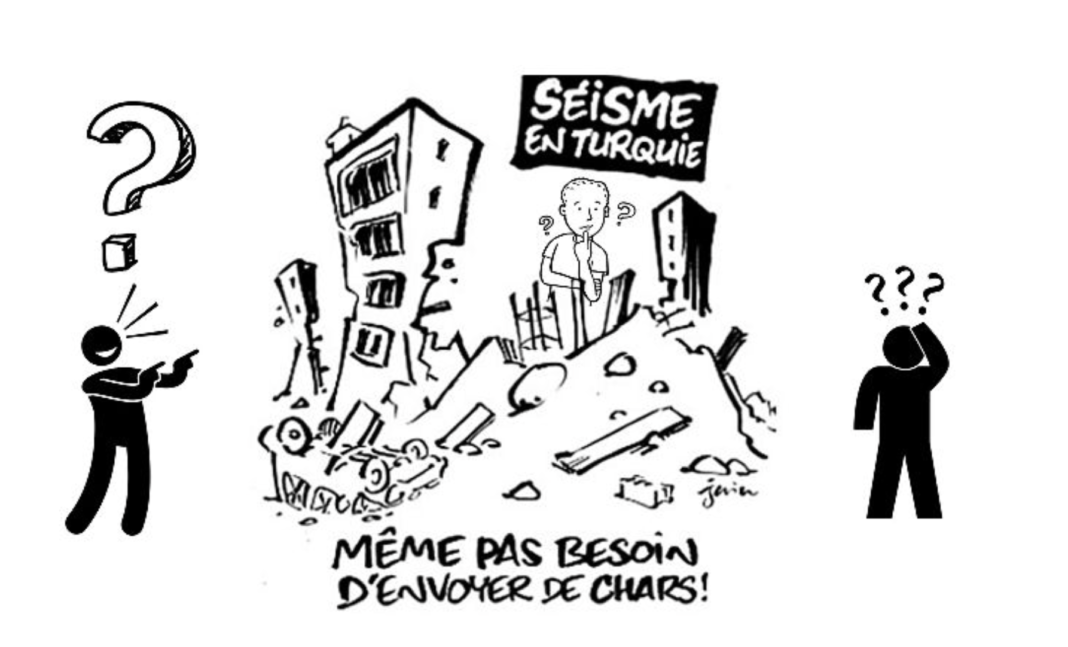« The French weekly magazine Charlie Hebdo’s cartoon about the earthquake in Turkiye is continuing to receive negative criticism from all over the world. » Kerem Congar reports in Euronews on February 10, 2023.
Not only in Turkish society but several European nations and other countries have been reacting to its caricature.
On February 6, Turkiye was shaken by two separate earthquakes, the center of which was Kahramanmaraş. This earthquake has been considered the biggest earthquake disaster in Turkey’s modern history.
More than 10,000 people are now reported to have been killed but that figure is expected, by some, to rise substantially. The fault line has been effective in 10 different provinces with a total population of 13 million, and tens of thousands of people are waiting to be rescued under the rubble in the cold wintry conditions.
The image published by Charlie Hebdo on the same day of the earthquake with the title « Cartoon of the Day » reads « Earthquake in Turkiye. Even, no need to send tanks. »
Charlie Hebdo is, of course, well known for its sharp tongue and sarcastic approach. Many of the cartoons it published in the past have caused widespread anger. But this, arguably, is the magazine’s lowest and most inappropriate point.
Founder of Linguo platform teacher and entrepreneur Mohamed Hassissi, who has around 250,000 Instagram followers said: « A big earthquake hit a country. And thousands of innocent people die including children and probably thousands of people will die cause they’re under the rubble. Only people sick at heart find it funny and ridicule that, unfortunately. That’s what the French magazine Charlie Hebdo has done. »
Hassissi added that Charlie Hebdo has done the same thing before, referring to the « hatred caricatures » of Prophet Mohammed in 2015.
« Modern barbarians! Fascist humour »
CNN Türk, one of Turkiye’s leading news channels, described the cartoon as scandalous. Turkiye’s Presidential spokesperson İbrahim Kalın also reacted sharply: « Modern barbarians! Drown in your grudge and hatred. »
Sentiments shared by the Algerian-French journalist Khaled Sid Mohand and Moroccan-French academic doctor Yannis Mahil who both said the cartoon was a prime example of « fascist humour ».
« This so-called humour is the humour of the far right, it is a fascist humor. Muslims have become Charlie Hebdo’s obsession in the last 25 years, » according to Mohand.
French academic Yannis Mahil also noted that when « fanaticism and sarcasm » reach an advanced level, humour becomes hate speech.
« Charlie Hebdo’s target is mostly Muslims, immigrants, Africans and Asians. The magazine knows exactly who to target and how to hide its hatred behind free speech and humour. » said Mahil.
It’s perhaps, however, wrong to say that Charlie Hebdo only mocks minorities, Muslims, and foreigners. The French magazine triggered another almighty row after a 2016 earthquake in Italy, it published a cartoon comparing the earthquake victims to the country’s famous lasagna dish.
About Charlie Hebdo
Charlie Hebdo was first published in France in 1960 as Hara-Kiri Hebdo. The magazine changed its name to Charlie Hebdo the following year. Charlie Hebdo, a left-anarchist-leaning magazine published on Wednesdays, ceased publication in 1981. However, it was re-published in 1992. After the cartoons it published about the Prophet Muhammad, a group of Islamist gunmen stormed the magazine’s Paris headquarters on January 7, 2015, an attack in which 12 people lost their lives.
It was the first of a series of violent terrorist incidents over three days that ended with hostages being held in a supermarket and brought panic and police to the streets of the French capital.
In response, thousands of people later, along with many world leaders, rallied in a joint show of solidarity and support for the victims.
Euronews on February 10, 2023, by Kerem Congar.

